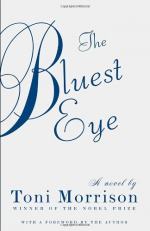|
|
The Bluest Eye Topic Tracking: Beauty
Beauty 1: Claudia is constantly faced with white ideals of beauty. For Christmas one year, she receives a blue-eyed, blonde-haired, pink-skinned doll. Rather than adore the doll, she destroys and dismembers it as a result of her anger. Claudia feels she can never measure up to the beauty of white children, the beauty that all the world reveres.
Beauty 2: The Breedloves are poor and ugly. At least that is how they think the world views them. Their beliefs that they are ugly come from white American media always portraying whites as representations of what is beautiful. Because of this, they do not strive for more, for they think that they do not deserve to have more.
Beauty 3: Pecola wishes that she had blue eyes. She thinks that if her eyes were blue, and therefore beautiful according to white American standards, then her problems would go away and her life would be beautiful. Then maybe, her classmates and teachers would not despise her and think she was so ugly. She so hates herself that she stares at herself in the mirror trying to figure out where her ugliness comes from.
Beauty 4: For one year Pecola prays that her eyes will turn blue. She has many problems in her life, starting with family issues, and she thinks that if she had blue eyes, her problems might go away. And even more than that, if she had blue eyes, people would see her as beautiful, and then she would be able to see herself as beautiful too. Being a black little girl in a society that idolizes blonde-haired blue-eyed beauty, Pecola thinks she is ugly. Pecola sympathizes for the dandelions because she knows what it is like to be devalued. She finds beauty in the weeds, for she thinks that people see her as a weed.
Beauty 5: A new little girl, named Maureen Peal, comes to Claudia and Frieda's school. Maureen is revered for her looks, which people deem beautiful. She has lighter skin and eyes than most of the other children, and everyone adores her because of this. She is looked upon as beautiful because her characteristics are somewhat more "white" than other black people's. This causes many to be jealous of her. However, Claudia and Frieda are not jealous. They see through the standards placed on beauty, and if Maureen is what is beautiful, this means that they are not beautiful (according to society).
Beauty 6: When the girls are walking home from getting ice cream after school, they pass a movie theater with a picture of Betty Grable on the building. Maureen and Pecola both say that they love Betty Grable, an icon for white American beauty with her blonde hair and blue eyes. However, showing her disdain for such standards placed on beauty, Claudia says that she prefers the actress, Hedy Lamarr, who has dark hair.
Beauty 7: In her younger years, Pauline Breedlove occupied herself by going to the movies. It was here that she got her first glimpse into what idealized beauty was. She saw the Hollywood blonde-haired, blue-eyed bombshells as being true representations of beauty. And anything that strayed from these looks, including her own, was seen as not pretty. American society placed their standards of beauty onto the world, and because of this, many people began to realize how far away they were from those standards.
Beauty 8: Pecola goes to visit Soaphead Church with the hope that he will be able to fulfill her wish to have blue eyes. She thinks that with blue eyes, all of her problems will disappear and the world will love her because she will be beautiful. The world, seen through blue eyes, will also appear beautiful to Pecola.
Beauty 9: Claudia prays that Pecola's baby will survive. She needs the baby to live to counteract society's standards set on beauty, which say that blonde-haired, blue-eyed little girls are all that is pretty. Claudia hopes that with this new black baby people will change and see blackness as something that can be admired and something that is beautiful.




